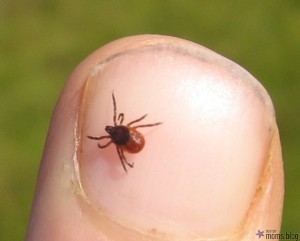
I’m going to admit it: I don’t like bugs.
Sure, I put on a brave front. My kids don’t know that I shudder inside as I squish the spiders, even when they make that crunchy sound. There’s a few bugs that aren’t so bad, like grasshoppers and ladybugs. And I know that bees are essential for our food chain so I try not to flinch when they get near me. Oh, and I’ve definitely gotten up close and personal with worms to show them to my kids–a great way to inspire a sense of wonder. But bug bugs–like cockroaches and beetles and flies–those are super gross, in my humble opinion.
When I lived in New York City, one of my biggest fears was bedbugs. But now that we’ve moved to the suburbs and the kids are spending more time outside, I have a new fear: ticks.
Growing up, ticks weren’t so bad. I don’t think I ever had one, though our dog certainly did. But the diseases that ticks carry have gotten worse over the past 25 years or so. According to Melinda Wenner Moyer’s recent article on Slate, we are all in serious trouble if we don’t take the danger of ticks seriously. It’s not just Lyme disease anymore (which, though treatable, is often misdiagnosed and can have serious, lingering side effects for many people.) Other diseases include anaplasmosis and babesiosis, both of which can also be hard to diagnose. And the worst of all: powassan virus which is a viral infection that we haven’t yet figured out how to treat and can result in hospitalization and death.
So what can you do?
1. Preemptively treat your shoes and clothes
Moyer recommends a pesticide called permethrin which you spray on your shoes until they are saturated, and then let them dry. (Yes, I’m sure that many of you aren’t fans of pesticides. Personally, I would prefer a pesticide over the side effects of tick-borne diseases, but check the research and make your own decision.) You can also treat your clothes this way [here’s a short video to show you how] which will keep ticks away for 5-6 washes.
2. Check for ticks daily
Ticks love warm bodies, and they especially love cracks and crevices. Ticks can be tiny so you really need to be thorough when checking. I’m talking thorough. Armpits, elbows, backs of knees, genitals, butt crack. If it’s warm, that’s where ticks want to be.
3. If you find ticks, remove them
Last summer we spent a weekend in upstate New York with a bunch of friends, and did nightly tick checks. Thank goodness we did, because one of the 5-year-olds had a tick in each armpit. (Let me tell you that pulling small ticks out of the armpits of a screaming kindergartener was one of the most stressful experiences of my life!) But it’s so important. The best way to remove a tick is with tweezers. Disinfect with alcohol, grasp as much of the tick’s body as possible and pull out with a slightly upward motion. Do your best to get as much of the tick out as possible, but luckily the head and mouth parts do not continue to transmit disease after being removed from the body. Here’s a great how-to video from the University of Rhode Island’s Tick Encounter Center if you want a little extra help.
This is important for your health and your family’s health. A great resource to read more is at URI’s Tick Encounter Center, and UMASS-Amherst even has a center where you can mail them your tick and they’ll identify it for you. And of course the Centers for Disease Control website is the best place to check for information about tick-borne diseases.
Stay smart, stay safe, and check for ticks daily!












